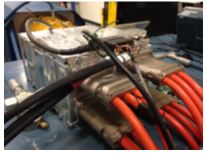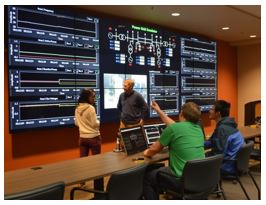|
Power Electronics Education and Research
Graduate programs offering specialized training in power electronics provide new engineers with the educational foundation for working in a range of industries. They also conduct fundamental research paving the way for development of more advanced power semiconductors, power converters, and power systems.
Originally presented in How2Power Today’s Spotlight on Education & Research, these articles provide detailed overviews of power electronics programs around the world. In these articles, a representative of each organization discusses various aspects of its power electronics program such as:
- origins of the program
- who’s who on the faculty
- areas of focus for research and interesting research projects
- collaborations with industry
- laboratory facilities
- number of students, post docs and support staff
- other unique aspects of the program.
If you’re interested in submitting an article about the power electronics program at your institution, contact the editor.
|
PowerAmerica: Accelerating The Next Generation Of Wide-Bandgap Power Electronics
by Julia Casadonte, Communications Manager, PowerAmerica, Raleigh, N.C.
Power electronics systems based on silicon carbide (SiC) and gallium nitride (GaN) semiconductors are becoming mainstream. Supporting the transition to these long-anticipated technologies is PowerAmerica, a consortium of nearly 50 industry and university members focused on accelerating the adoption of SiC and GaN technology in a wide range of power electronics systems. Based at North Carolina State University, members range from startups to multinational corporations, as well as top research universities across the U.S. Since its inception in January 2015, PowerAmerica has awarded funding of approximately $44 million (excluding 1:1 cost matching) for 59 SiC and GaN projects in the areas of large volume power device fabrication, module development, device reliability, and power electronic applications—all boosting manufacturing in the United States. Funding for these projects is provided by the U.S. Department of Energy, the state of North Carolina, industry, and academia. Read the full story…
|

A collaboration between John Deere
and the DoE’s National Renewable
Energy Laboratory developed
this
high-power SiC traction
inverter to
electrify heavy-duty
construction vehicles. |


|
|
WEMPEC Celebrates 35 Years Of Research And Education In Power Electronics And Motors
by James Sember, WEMPEC Executive Director, Madison, Wisc.
The applications for motor design, power electronics, and controls in electric vehicles, wind and solar power are growing exponentially. As it celebrates its 35th anniversary this year, the Wisconsin Electric Machines and Power Electronics Consortium (WEMPEC) continues to research these areas in ways that are still unparalleled at any other university or industry consortium. WEMPEC is combining research and education in the areas of motor design, power electronic converter design, and motor control. Some of WEMPEC’s most important research is being done in advanced machines, power converter topologies and controls and sensor technology. Electric machine research at WEMPEC has earned an international reputation for its history of ground-breaking innovations ranging from axial-airgap machines to double-airgap machines and, more recently, flux switching machines, variable flux permanent magnet machines, and electrostatic machines. Read the full story…
|

WEMPEC focuses on electric machines
because
of the critical role they play in
producing
and using electric energy. |


|
|
CURENT Develops Power Electronics For A More-Resilient Electrical Grid
by Leon Tolbert, Center For Ultra-Wide-Area Resilient Electric Energy Transmission Networks (CURENT), Knoxville, Tenn.
CURENT, the Center for Ultra-Wide-Area Resilient Electric Energy Transmission Networks, is one of five National Science Foundation (NSF) Engineering Research Centers focused on energy and infrastructure. It is the result of a collaboration between academia, industry and national laboratories and is jointly supported by NSF and the U.S. Department of Energy. The center itself is a partnership of four research institutions led by the University of Tennessee in Knoxville, TN (UTK) and includes Northeastern University, Rensselaer Polytechnic Institute, and Tuskegee University. The CURENT vision is to develop a nationwide or continent-wide transmission grid that is fully monitored and dynamically controlled in real-time for high efficiency, high reliability, low cost, better accommodation of renewable energy sources, full utilization of energy storage, and accommodation of responsive load. CURENT looks to develop technologies that enable ultra-wide-area grid control, high penetration of renewables and better reliability, and there is a need to develop a system for demonstrating and verifying such technologies. Read the full story… |

CURENT’s Visualization room.
|
Aalborg University Fosters Multi-Disciplinary Approach To Research In Efficient And Reliable Power Electronics
by Huai Wang and Frede Blaabjerg, Department of Energy Technology, Aalborg University, Denmark
Power electronics is one of the strategic areas of study at Aalborg University and the work being conducted in this area is meant to produce new knowledge and candidates for the surrounding society nationally and internationally. It is one of the six research and education sections within the university’s Department of Energy Technology. This department has a unique academic combination, since competences in electrical, thermal, fluid power and mechanical energy are placed within the same unit, working collaboratively in the field of power electronics and its applications. This multi-disciplinary approach benefits a number of research programs that focus on renewable energy, efficient energy consumption and distribution, conversion technologies and control of energy. Efficient and Reliable Power Electronics is the core power electronics program, together with three programs on Wind Turbine Systems, Photovoltaic Systems and Microgrids, and Automotive and Industrial Drives, where the application of power electronics is intensive. Five other programs are also heavily involved with power electronics activities. Read the full story… |

Aalborg University’s multi-disciplinary
research programs. |
|
NSF Center For Grid-Connected Advanced Power Electronic Systems Accelerates Adoption Of Power Electronics In The Electric Grid
by T. A. Walton, Alan Mantooth, Roger Dougal and Juan Balda, GRAPES, Fayetteville, Ark.
The National Science Foundation (NSF) Center for GRid-connected Advanced Power Electronic Systems (GRAPES) is devoted to investigating new technologies, algorithms, software, and deployment strategies involving power electronic systems for the nation’s electric power grid. GRAPES, which was established by the University of Arkansas and the University of South Carolina and funded by NSF, not only conducts research but also works to transfer innovative technologies to industry. Morever, the center aims to accelerate the adoption and insertion of power electronics into the electric grid to improve system stability, flexibility, robustness, and economy. In this article, GRAPES leaders explain the center’s guiding principles; introduce its researchers, staff and member companies; describe its extensive facilities and highlight current research projects. These projects include an optical control for SiC and GaN devices, a modular multi-level converter for transmission-level battery storage, a smart green power node, high-voltage power module packaging, a power module layout synthesis tool, and dense power electronic interfaces for distributed generation. Read the full story…
|

GRAPES’ National Center for
Reliable Electric Power Transmission.
|
|
Advancement Of The Smart Grid Starts With FREEDM
by Kelsey Kusterer, FREEDM Systems Center, Raleigh, N.C.
The FREEDM Systems Center is a National Science Foundation Engineering Research Center that aims to develop the knowledge base for the FREEDM system—a new model of the Smart Grid—and provide fundamental breakthrough technology in energy storage, power semiconductor devices, and distributed controls. In this column, Kelsey Kusterer discusses the unique mission of the FREEDM Systems Center, which aims to bridge the gap between research, education and industry to forge a successful partnership in revamping the electric grid. Kusterer describes how the center’s extensive resources and relationships are being deployed to meet these goals, and how the center works to develop both Smart Grid technologies and leaders. Read the full story… |

Grad student adjusts dynamometer
at the FREEDM Systems Center.
|
|
Missouri S&T’s Wide Ranging Power Program Covers The PE Spectrum
by Jonathan Kimball, Missouri University of Science and Technology, Rolla, Mo.
Missouri University of Science and Technology (Missouri S&T) is the engineering-focused campus of the University of Missouri System. At the undergraduate level, there are 15 accredited engineering degree programs and approximately 80% of all students are enrolled in engineering programs. One of the largest departments on campus is electrical and computer engineering. This department offers a graduate curriculum in power engineering that allows graduate students both to delve deeply into a particular topic and to broaden their experience across the spectrum of power electronics (PE), power systems, and electric machines. In this column, Dr. Jonathan Kimball presents an overview of the university’s power electronics program including its faculty, special research facilities, and collaborative research projects. Read the full story… |

Missouri S&T’s Emerson Electric
Company’s Drives Laboratory.
|
|











